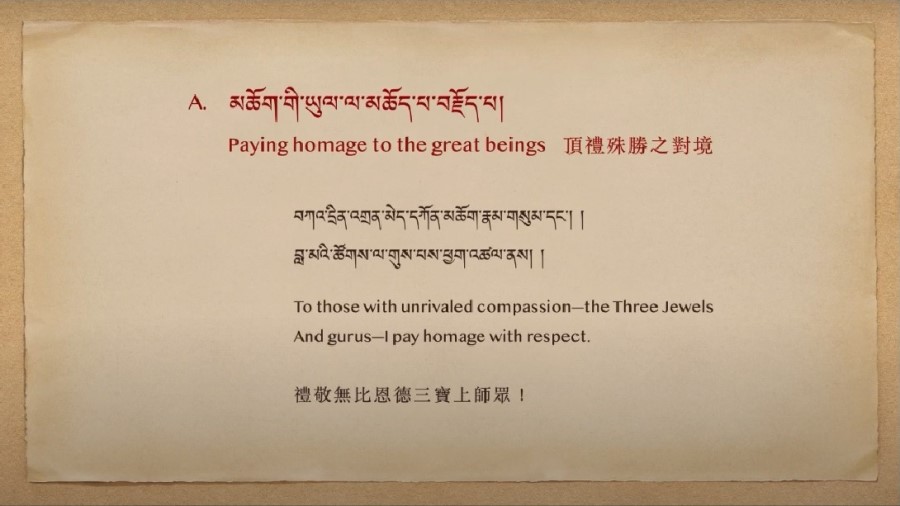法王新闻 | 2021年02月
『第6届谶摩春季』噶玛巴米觉多杰自传•第2天第2堂課
『6th Arya Kshema』AUTOBIOGRAPHICAL VERSES OF KARMAPA MIKYÖ DORJE•2-2
༸རྗེ་བརྒྱད་པ་མི་བསྐྱོད་ཞབས་ཀྱི་རྣམ་ཐར་བཀའ་ཁྲིད། བདེ་བྱེད་མའི་དཔྱིད་ཆོས་ཉིན་གཉིས་པ།

時間:2021年2月16日晚上10:30-11:30(北京/台北/香港) February 16, 2021
中文口译:堪布丹杰
中文稿来源:kagyuoffice.org.tw
校对修改:释妙竹
English source from: aryakshema website
《妙行自传》科判和第七根本堕
好的,大家都听得到吗?听得到请举手。
「妙行」之意
那么继续讲解。刚刚简略地介绍了一下「རྣམ་ཐར།།」(解脱行传),接着為什麼這部自傳稱為《妙行》 呢?此傳中一再提到「此謂我妙行之一。」亦即作者介紹了其生平的三十三個妙行,所以這篇自傳稱為《妙行》。
什麼是「妙行」?「妙行」指的是善行、好的行為,譬如《入菩薩行論》的內文說:「施供善逝等,一切諸福善。」這裡所指的「妙行」是:善妙的行持。《俱舍論》也說:「三清淨應知,即諸三妙行,惡身語意業,說名三惡行,及貪瞋邪見,三妙行翻此。」
For the second part of his teachings, His Holiness directed our attention to the text Good Deeds. Mikyö Dorje’s liberation story recounts thirty-three of his different good deeds. His Holiness rhetorically asked and replied, “What is a good deed? A good deed should be understood as a virtuous act.”
佛陀在經典提到所謂「三妙行」和「三惡行」——正是因為身業等等的不善行,會受到聖者的批評,且會招致不舒心的果報,所以稱這種行為「惡行」;與其相反地,善行則會受到聖者的讚譽,所以稱為「妙行」。「妙行」也稱為「清淨」,故「三妙行」亦稱為「三清淨」;這是因為身、語、意各自的善行,皆會淨化身、語、意本身。之所以稱為「清淨」,是因為它們能暫時,或究竟地淨化身語意的惡行污垢,所以稱之為「清淨」。而「貪奪心」等雖不是意業道,但因其帶有煩惱,所以屬於意的惡行。
In the sutras, the Buddha taught the three types of harmful deeds and good deeds. Harmful deeds refer to the unvirtuous actions of body and so forth whereas the virtuous actions of the body and so forth are called good deeds.
The three types of good deeds are also called purifiers. For example, all the good deeds of body, purify the body, the good deeds of speech, purify speech, and the good deeds of mind, purify mind. The reason they are called purifiers is that the stains of harmful actions of body, speech, and mind are purified through good deeds.
这一段大家会知道「妙行」的意思。接着讲解《妙行自传》的内容。
首先根據桑傑巴珠,他的传记之后会再讲解。他是第八世噶瑪巴米覺多傑的親傳弟子,他寫了一部註解,列出了《妙行傳》的科判,所以我会配合科判来讲解这部论。 此傳共有三個大段落,或是三大提要:
Sangye Paldrup, a direct disciple of Mikyö Dorje, wrote a meaning commentary on Good Deeds with an outline of three main sections of the text as follows:

《妙行自赞》科判总述——三主要部分 རྣམ་ཐར་ལེགས་སྤྱད་མའི་རྩ་བའི་དོན་ཚན་གསུམ།
The Autobiographical Verses called “The Good Deeds” have three main sections:
I.頂禮暨立誓造傳 Homage and pledge to compose མཆོད་པ་བརྗོད་ཅིང་རྩོམ་པར་དམ་བཅའ་བ།
II.傳記本體 The nature of the biography བརྩམ་བྱ་རྣམ་ཐར་གྱི་རང་བཞིན།
III.造論圓滿 Conclusion རྩོམ་པ་མཐར་ཕྱིན་པའི་བྱ་བ།

其中第一个又可以分為「頂禮殊勝之對境」和「造傳立誓」兩個部分。
For this teaching, His Holiness covered the first topic. Regarding the first section it is divided into two parts, paying homage to great beings and the pledge to compose, as seen in the verses:
Bamboo打着哈欠问:这些无聊的科判,研究半天有什么用呢?
A. 頂禮殊勝之對境 Paying homage to the great beings མཆོག་གི་ཡུལ་ལ་མཆོད་པ་བརྗོད་པ།

首先,頂禮殊勝之對境的文句是:「禮敬無比恩德三寶上師眾!」
Among the first of these two parts is paying homage to the great beings; the text states: To those with unrivaled compassion—the Three Jewels And gurus—I pay homage with respect.
簡言之,作者米觉多杰頂禮的對象是珍貴的三寶和上師們。我們如何向三寶和上師頂禮呢?首先要瞭解,此處的佛寶是大乘所主張的「具有三身自性者」,法寶是「已離欲之滅諦」和「令離欲之道諦」,僧寶則是具有「明、解」兩種功德的大乘不退轉聖僧。而這一切的根本,就是真實吉祥上師——桑傑年巴為首的,等等堪能應供與讚嘆的上師們。作者首先向他們頂禮。
His Holiness explained the meaning in general terms. Mikyö Dorje is paying homage to the Three Jewels and the gurus. He is prostrating to them. What are these three jewels and who are the gurus to whom he pays homage? The Three Jewels refers to the Buddha as described in the Mahayana – a buddha with the nature of the three kayas. The Dharma means the truth of cessation, freedom from attachment, and the truth of the path which leads to freedom. The Sangha is the irreversible noble beings with the qualities of awareness and liberation. The basis for that is all them, is all glorious gurus.
這裡作者並沒有直接切入論體,反而是先行禮讚,这么做的原因和目的是什麼呢?這是因為作者米覺多傑他此生與來生的一切終極目標,就是為了救護盡虛空一切的眾生,離開無邊苦痛,幫助眾生暫時上得到利益、究竟上得到勝樂。(Bamboo批:听到这么装逼的话,就知此人有多虚伪)若要完成這樣的目標,勢必得受到三寶的輔助和照護,以及一切真實總持上師的慈悲和恩德,才可能達成。他們對於米覺多傑法王而言,是非常重要、恩德極大的存在,此外不需要其餘的皈依處或惡友的支持,所以此處強調三寶與上師是「無比」。
Gyalwang Karmapa noted, “The homage is extremely important.” Generally in Tibet, all authors begin texts with an homage to the buddhas, bodhisattvas, and gurus. The purpose of this is to prevent any obstacles to writing or completion of the text. As His Holiness explained, Good Deeds begins with prostrations, offerings, and praise because Mikyö Dorje’s greatest aim was to protect all sentient beings from endless suffering now and in future lifetimes. Writing his autobiography depended upon favorable conditions including the kindness and great compassion of the Three Jewels and the great lineage holders.
一般而言,藏族論師在寫下任何著作之前,習慣於開頭頂禮諸佛菩薩和自己的上師,一種說法是,這麼做的目的,是作者為了平息造論過程中的障礙,讓造論能順利圓滿,同時也有依循善行的目的。這也符合噶當派認為皈依的學處,是「在任何行動前都要先頂禮供養三寶」的這種說法;同時:若能在任何正行之前,都先這麼做的話,也就是做到顶礼、供养的话,即使沒有完成正行,其實也與完成無異了。噶当派還說道:沒有任何方式,會比「深信上師與三寶」還更有效力達到除障和滿願的目的。 由于这种种的原因,开头顶礼是很重要的。
As emphasized in the Kadampa oral tradition, no matter what action you do, you should prostrate and make offerings to the Three Jewels. Prostrating to the Three Jewels and the gurus removes obstacles and helps us accomplish our desired aims. In fact, there is nothing more powerful than having belief in the Three Jewels and the gurus.
B. 造傳立誓 Pledge to compose རྩོམ་པར་དམ་བཅའ་བ།

其次,造傳立誓可以分成五個細目:
His Holiness then turned to the second of these two parts – the pledge to compose. This comprises five different points:
一、自謙詞 Expression of modesty ཁེངས་པ་སྐྱུངས་བ།
二、為利有信法器 How this is for the faithful and receptive སྣོད་ལྡན་དད་ཆེད།
三、誓詞 The actual topic བརྗོད་བྱ་དངོས།
四、遮止非時 Refuting that this is inappropriate སྐབས་མིན་སྤང་བ།
五、釐清毀謗 Dispelling exaggerations and denials སྒྲོ་སྐུར་བསལ་བ།

一,自謙詞:For the expression of modesty, we see the line:
自謙詞是「大德若見,不覺為奇。」這一段的意思是,米覺多傑認為:對於那些不再迷惑如何取捨,並且能如實教導他人取捨方法的大德們,他自己的這些經驗與體會並不奇特,他們不會對此感到驚訝與歡喜,因為他們这些大德早已深感輪迴苦樂,心生高遠的涅槃體證,所以不會覺得自己的传记内容有什麼特殊之處。
「Great beings would see nothing wondrous here」,
The meaning of this line is that the great beings are already free from delusion about what should be done or rejected. Great beings would not feel amazement since they have already reached nirvana and omniscience.
二,為利有信法器: How this is for the faithful and receptive
「為利有信法器」是「卻為俗子雀躍之事。」對於善緣俗子,他們的心態比較開放,虔信大乘,且具有清晰的思辨能力。那麼,这些具备善缘的俗子,他們如果閱讀、聽聞這部傳記,應該能生起信心,感到歡喜,進而願意隨學這部傳記的修行内容。所以,米觉多杰说,是為了利益這些善缘俗子而寫的。 三,誓詞:the actual topic 誓詞是「謂我妙行數數。」意指作者自認自生造作了許多善行和好事。 四,遮止非時:refuting that this is inappropriate 遮止非時是「道於他人,或能利彼,諸尊敦請,故撰此文。」設問:作者寫下這部傳記,是為了迎合世間八法,或是為了捏造自己所沒有的功德,還是為了誇大自己的功德而寫?都不是。米觉多杰写这部传记的缘起,是因为他的弟子们不断地再再敦请之下而写的,是由哪些弟子敦请呢?在桑吉巴珠的传记中写道:弟子中有第五世夏瑪巴——昆秋顏拉、直貢第十五代法座——直貢仁謙卻傑、第三世嘉察札巴巴就、第二世巴沃祖拉成瓦、班智達多傑加波等等眾多的弟子,再再敦請之下而撰寫的。(Bamboo批:应这些他认证的转世祖古的马屁而写的,吹嘘自个的文章。) 五,釐清毀謗:dispelling exaggerations and denials 釐清毀謗,是「最了己所更事。」如果说他的传记是由别人来写的话,会变成怎样呢?可能就变成「把沒有的說成有的」这种「增益」,或「把有的說成沒有」而「減損」;只有自己對自己身語意的善行和惡行有最完整的經驗和認識,同时也只有自己對自己是最清楚,是沒有秘密的。所以,作者米觉多杰承諾撰写。在传记的篇幅上來看,它的言辞簡約,但意義深遠。 第七根本墮 古印度書寫歷史的傳統似乎不太興盛,也因此,龍樹、無著兄弟等等的紀錄皆不甚明確,所以大家就连龍樹存活多久,是否長達數百年…等等,這些議題都沒有共識。相反,中國文化是很重視歷史紀錄的,任何一位印度智者前往中國之後,常常他們的年份與經歷皆會被清楚記載。 西藏文化也相當重視歷史,所以我認為如果當年阿底峽尊者沒有到藏地弘法,或許他在歷史上僅留下名字,而沒有其他更多詳細資料。所以我們都聽說印度有許多大成就者,但只聽說他們的名稱,很多時候都找不到他们更多詳細的資料。 大部分由弟子所寫上師的傳記,內容大多都是有過多讚譽與誇飾,許多偏離史實,在第三世法王讓炯多傑的弟子嘉華.永東巴在自傳開頭寫:「我並沒有任何廣大的佛行事業,或者利益眾生的偉大事蹟,若要將自己沒有的事情說成有,會犯下上人法妄語而破戒。」 我们常说,许多根本堕罪,最容易犯的就是自己沒有而說有,譬如根本沒有見到本尊,卻說自己見到本尊;沒有任何了悟心性,卻說自己了悟心性;彷彿自己證悟甚深,眼睛都只能朝上,讓人看了覺得似乎很厲害。如果没有证悟,却说自己证悟了,就犯下了妄说上人法的根本堕罪。 接著在傳記中寫道:「分享其中部分內容會違反第七根本墮。」这段是说,如果我們刻意大肆宣傳自己造作的一點點善行,佛陀說這樣反而會讓善業毀損;如果做了一點善行、累積了一點福德,便急著四處向人宣說。甚至周围没人,现在来讲,赶快就透過網路發文昭告天下。如果不注意,其實這樣的作為會毀壞你的善行福德。佛陀是这么说的。 四大教派都會引用这句话:「大部分由弟子所寫的傳記都有過度讚譽矯飾上師之嫌,而我寫下的這個簡略自傳毫無增減,若有讀者不滿意、不理解,而認為我有說謊之嫌,請客觀的觀察分析上述內容是否合理後,再提出矛盾之處。」 His Holiness ended the session by elaborating on this. When the students write their guru’s liberation stories, they make too many proclamations and only praise the guru. But when the guru composes his own story, his experience of liberation is clearly recorded, just as seen in the Good Deeds. 噶瑪洽美在傳記中說,他有外內密許多的傳記,為什麼要寫這些外內密的傳記?他传记的方式很特别,是用问答的方式写的。噶玛恰美是他比丘的名字。然后他用另一个名字,自己跟自己辩证的方式,说明为什么写这样的传记:「設問:自造自傳並不合理,因為沒有如此做的理由。則應回答:此推理不成立,如此做的理由非常明確。因為個人感受到的徵兆與體證只有自己知道,弟子們是沒有經驗的,所以非自己記錄下來不可。」也就是說,自己對自己的想法,以及佛法上的感受和體證,自己是最能理解的,撰寫自傳的價值就特別重要。 總之,如同前述,只有大德的傳記才能稱作「解脫行傳」,一般人的傳記不能有這樣的稱譽,現在許多人不知這個道理,也會將某某人或自己的某傳記就稱為「某某人的解脫行傳」。之后,有一位智者,就有提到,世俗凡人根本连轮回中的一根指头都没有浮出来,怎么能够写自己的自传,叫《解脱行传》是更不可能的。 今天就讲到这里,真正的三十多个妙行,明天会讲到。許多人跟我说:你这只有22堂課,卻有33個偈文要說,不只這樣,還有《無比自讚》要講,你怎麼说得完?所以,如果不說快一點也不行,但有一些部分不多做解釋也不行,或許講到後面,可能時間不夠的話,就只能唸過去了也不一定。接着,课诵跟回向,今天就講到這裡。
This relates to the line: But some childish beings might enjoy these words.
Childish beings refers to the ordinary individual, in particular, those who have a longing for the Mahayana. When they see or hear the story of Mikyö Dorje’s liberation, they might feel faith, develop delight, and train and follow in his example. He is teaching this liberation story specifically for their sake.

The text states:「 If I recounted some of my good deeds」. The meaning is that the author, Mikyö Dorje, will recount several of his good deeds.
The passage states:「 A few high masters have encouraged me
By saying that it would be meaningful」
His Holiness explained this passage. Here, Mikyö Dorje was neither influenced by the eight worldly dharmas nor is he a charlatan. In fact, the author did not feel that he had to tell this story but his students consistently encouraged him to do so.
The text reads: 「Since I know best what I experienced, I’ll relate a few.」
If someone else had written this liberation story, a different author, they might have exaggerated Mikyö Dorje’s qualities. Since his experience of his deeds is only vivid to him, he wrote the text himself.
Youtube 视频
